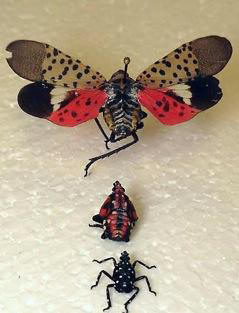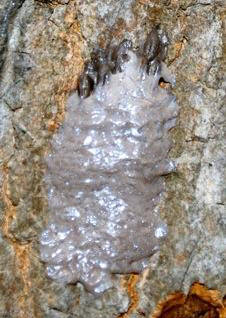 (12/7) Another insect pest courtesy of Asia again is causing damage and resulted in quarantine in many PA counties. It is the Spotted Lanternfly (Lycorma delicatula), first found in eastern Berks County in September of 2014. It has become a major pest attacking many trees and plants. It prefers
the Tree of Heaven, Ailanthus altissima, and that is a good thing since that tree is terribly invasive. BUT, it also likes grapes, apples, stone fruits, willows. pines and other forest trees. It feeds on both woody and non-woody plants, piercing tissue and sucking sap leaving sap weeping from the wounds.
(12/7) Another insect pest courtesy of Asia again is causing damage and resulted in quarantine in many PA counties. It is the Spotted Lanternfly (Lycorma delicatula), first found in eastern Berks County in September of 2014. It has become a major pest attacking many trees and plants. It prefers
the Tree of Heaven, Ailanthus altissima, and that is a good thing since that tree is terribly invasive. BUT, it also likes grapes, apples, stone fruits, willows. pines and other forest trees. It feeds on both woody and non-woody plants, piercing tissue and sucking sap leaving sap weeping from the wounds.
The Spotted Lanternfly lays egg masses in late September and continues through November or into early December. Eggs are laid on tree trunks, branches, rocks, and other man made solid objects such as deck supports, vehicles, campers, yard furniture, farm equipment or any other items stored outside.
 Egg masses are easily seen when they are freshly laid because of their mud-like covering. Once dry, they more resemble tree bark taking on a cracked appearance. Older egg masses appear as rows of 30-50 brownish seed-like deposits in 4-7 columns, roughly an inch long. If egg masses are discovered,
scrape them off, double bag them and throw them away. Eggs can be killed in alcohol or hand sanitizer.
Egg masses are easily seen when they are freshly laid because of their mud-like covering. Once dry, they more resemble tree bark taking on a cracked appearance. Older egg masses appear as rows of 30-50 brownish seed-like deposits in 4-7 columns, roughly an inch long. If egg masses are discovered,
scrape them off, double bag them and throw them away. Eggs can be killed in alcohol or hand sanitizer.
Nymphs hatch from the eggs in spring and seek out new host plants, including trees and over twenty-five Pennsylvania agricultural crops. Nymphs go through several stages to reach adulthood. Early young nymphs are black and white spotted. Older nymphs are black and red with white spots. Both stages can be present from May until October. Adults range in size from one
inch at rest to two inches with both wings open. Poor flyers, they are good at hopping. Adults have ovoid gray bodies with black spots. Once wings are open, their brilliant orange-red under wings are visible. See photos that accompany this article.
Affected trees and plants develop weeping sap wounds that leave a dark stain trail. The weeping sap attracts other insects such as ants and wasps to feed on the sweet sap. Trees and plants with heavy infestations may show black sooty mold fungal growth on leaves and black mounds at their bases. Damage can lead to stunting and eventually cause plant death.
In an attempt to limit the spread of this damaging invasive insect, the PA Department of Agriculture has established a quarantine order in municipalities where the Spotted Lanternfly already exists. All residents and businesses must comply with the regulations. Willful violators can be fined.
Because the area of quarantine continues to change as insect presence is discovered, visit the website below to see current areas of quarantine:
www.agriculture.pa.gov/protect/industry/spotted_lanternfly/pages/default.aspx
Currently quarantined counties include: Berks, Bucks, Carbon, Chester, Delaware, Lancaster, Lehigh, Monroe, Montgomery, Northampton, Philadelphia and Schuylkill.
Industries and regulated articles under the quarantine not to be removed or moved to a new area include any living stage of the Spotted Lanternfly. This includes egg masses, nymphs, and adults.
PLUS the following:
- Brush, debris, bark, or yard waste
- Landscaping, remodeling or construction waste
- Logs, stumps, or any tree parts
- Firewood of any species
- Grapevines for decorative purposes or as nursery stock
- Nursery stock
- Crated materials
- Outdoor household articles including lawn tractors and mowers, mowers, grills, grill and furniture covers, outside tarps, tile, and stone.
Report Spotted Lanternfly at 1-866-253-7189 or to Badbug@pa.gov.
Submit a photo of any life stage including egg masses. Report a suspected infected site. If unable to collect a specimen or take a photo, call the Automated Invasive Species Report Line at 1-866-253-7189 and leave a message detailing a sighting and contact information.
We as gardeners and the public are being asked to help prevent the spread of Spotted Lanternfly and take steps personally to limit any chance of spreading Spotted Lanternfly. Sources for this article include Penn State Department of Agriculture publications and the PA Department of Agriculture.